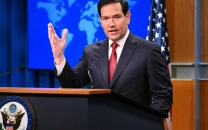Lal Masjid still red three years on

His habit might seem odd to an outsider, but many others like him recognise his need to satiate his allegiance to the “real” Lal Masjid. The new structure, renovated and beautified with the help of a business tycoon a few months after the operation, seems a facade to the controversial mosque’s most ardent followers.
The older entrance of the prayer hall exhibits poster-sized photographs of the pre-military operation Jamiya Hafsa and Lal Masjid. This is what Khalid seeks. He gazes at the photographs ritually, right after his ablution, before being ushered into the main hall.
“I stop for a while in front of these pictures everyday. My heart weeps for all that has happened to this place,” he said, after offering his Asr prayers.
“It takes me back in time. This place was not glorious because of its structure or colour. It was the people. These pictures do not show their faces but I can see them,” he said.
He also appears to be in perpetual torment over the “rationale behind killing thousands of girls.” When he was questioned over the authenticity of that figure, he retorted, “But that is what everyone says.”
“Is it not true that a large number of girls were killed in the operation? At least they should have been spared,” he said with anguish in his voice.
Khalid was not around when the military operation took place, but his views on the episode are straightforward and blunt. They echo the words inscribed on a new board that has been fixed at the site, where Jamiya Hafsa once stood.
The controversial board reads: “This was the site of one of the greatest universities of Islamic world, ‘Syeda Jamiya Hafsa Shaheeda’, which was martyred by the dictator of Pakistan, Pervez Musharraf, for the crime of trying to implement Shariah in the country.”
Khalid believes that the board is not offensive, and that most people conform to the idea behind it. “If that were not the case, the authorities would have removed the board and these pictures from the mosque,” he argued.
Such reminders of the incident and its aftermath enter the minds of almost every passerby, even those who never visited the place. Many questions about the event still emerge: the amount of devastation, the accurate number of people killed and the elements behind the debacle. But at least one thing holds true. The affiliation with the old landmark has not waned for people like Khalid even after the makeover of the mosque.
Lal Masjid’s renovation may be an attempt to move forward and wash away the bloody memory of the operation. But people like Ahsan Khalid, who have known the place for a long time, consider it a futile exercise. The boards and photographs make sure of that.
Published in The Express Tribune, July 18th, 2010.



















COMMENTS
Comments are moderated and generally will be posted if they are on-topic and not abusive.
For more information, please see our Comments FAQ